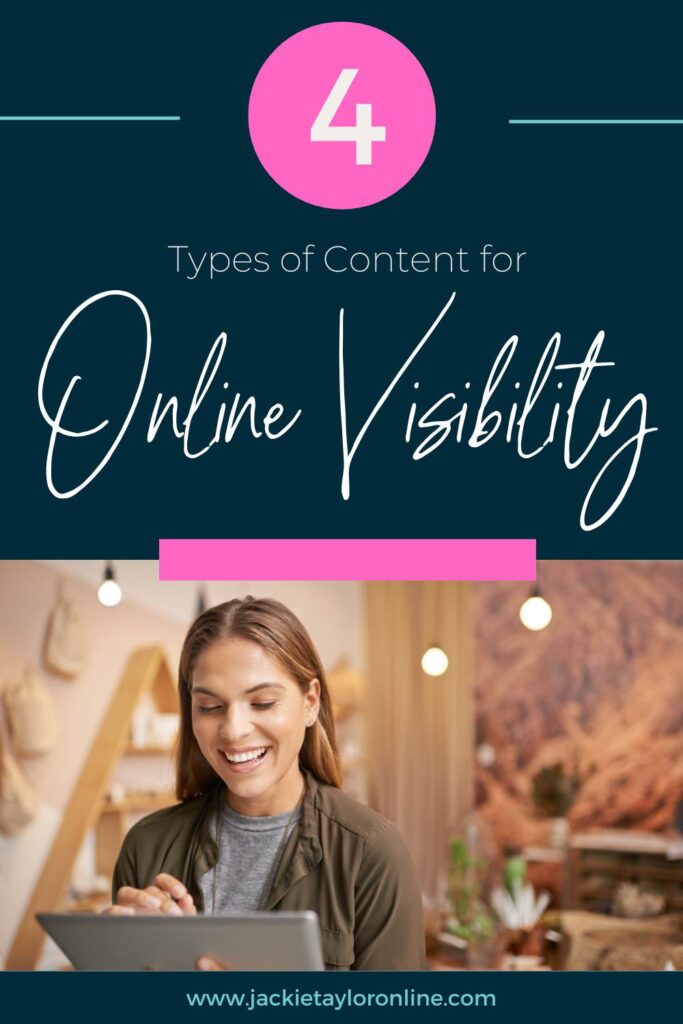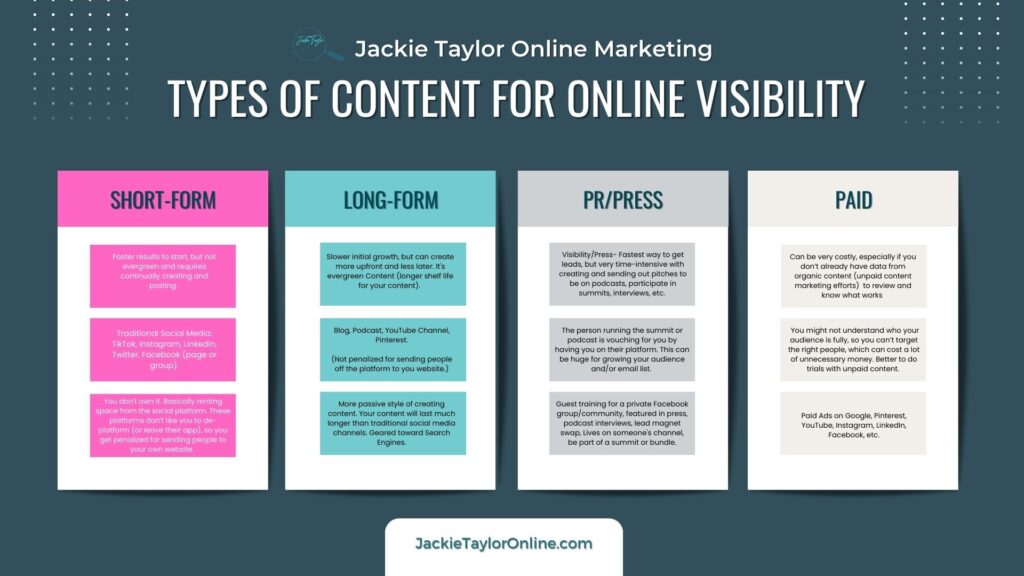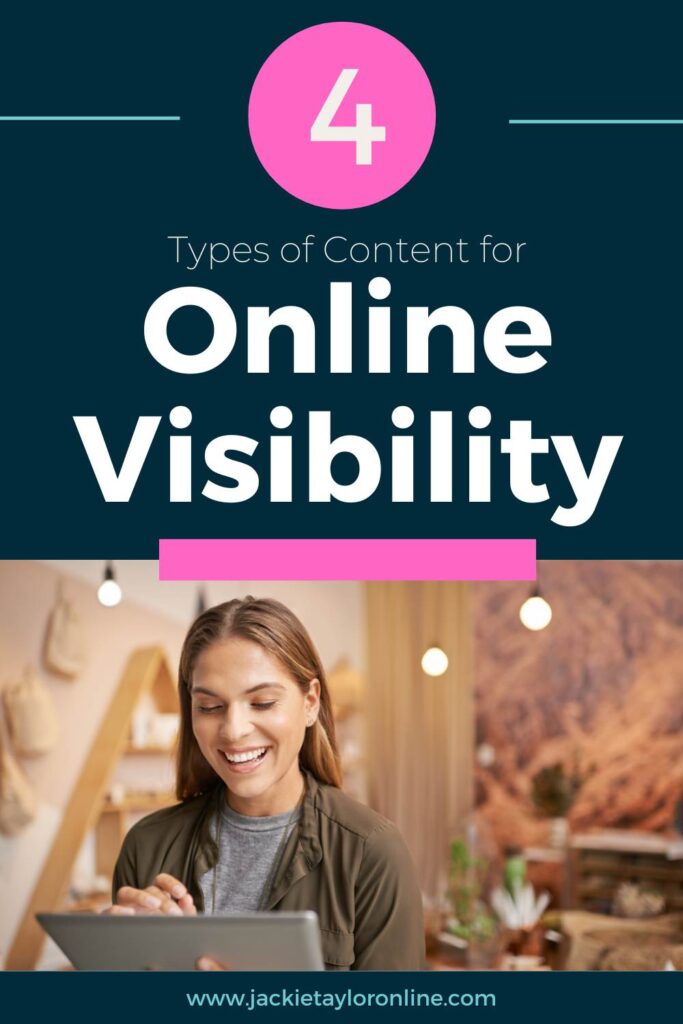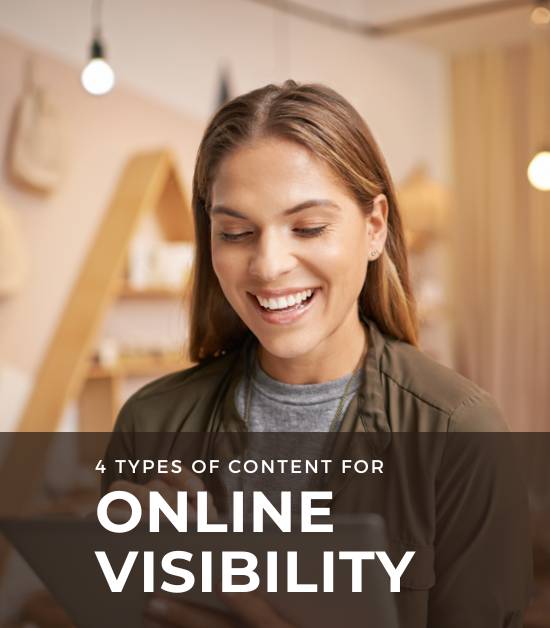There are four main types of content that you need in your content strategy. These 4 types of content for online visibility will help you decide what type of content you want to create. And what you’re realistically capable of creating (based on time and budget). As well as which would be best suited for your audience and your business goals.
Let’s get into the four types of content that you should consider for your online marketing plan. Then we’ll discuss how those compare with each other. And lastly, we’ll talk about how you can use each type of content or a combination of each to create the best content strategy for your specific business.
AFFILIATE DISCLAIMER: I SOMETIMES LINK TO PRODUCTS AND SERVICES TO HELP COVER THE COSTS OF RUNNING THIS BLOG. THERE’S NO EXTRA COST TO YOU – AND I ONLY RECOMMEND PRODUCTS THAT I’VE BOTH USED PERSONALLY AND THINK ARE QUALITY PRODUCTS THAT HELP WITH EFFICIENCY. PLEASE READ MY AFFILIATE DISCLOSURE FOR MORE INFORMATION. THANKS FOR YOUR SUPPORT!

Table of Contents
- 4 Types of Content Marketing
- Short Form Vs Long Form Content
4 Types of Content Marketing

1. Short-Form Content
Short-form content is the swift and snappy cousin of your content strategy. It’s all about delivering your message concisely and efficiently. In this category, we have a variety of formats, each designed for quick consumption.
What short-form content does for your business:
Short-form content serves as the sprinter of your content strategy, providing your business with quick bursts of impact:
- Immediate Engagement: Short-form content grabs your audience’s attention in the blink of an eye. It’s like an elevator pitch that works instantly.
- Quick Information Delivery: It’s perfect for delivering bite-sized information, making it easier for busy moms to grasp your message on the go.
- Ideal for Trend-Related Topics: Short-form content is your go-to choice for riding the wave of trending topics and staying relevant.
How short-form content works to promote your business:
Short-form content promotes your business by delivering quick and effective messages:
- Concise Messaging: Short-form content forces you to be clear and concise. It’s a fantastic tool for getting your core message across without overwhelming your audience.
- Social Media Engagement: Short-form content is tailor-made for social media platforms, where quick scrolling and instant engagement rule the game.
- Frequent Updates: It allows you to maintain a constant presence and keeps your audience engaged with regular, fresh content.
- Enhanced Visual Impact: Visual elements, such as images, gifs, and short videos, play a significant role in short-form content, making it engaging and shareable.
Types of short-form content includes:
Short-form content comes in various formats, each with its unique strengths:
- Social Media Posts: This includes short text updates, images, and quick videos on platforms like Facebook, Instagram, and Twitter.
- Microblogs: Think of platforms like Twitter, where you have a limited number of characters to deliver your message concisely.
- GIFs and Memes: These catchy, image-based content pieces are excellent for humor, quick expressions, or relatable moments.
- Short Videos (e.g., TikTok): These are typically under a minute, offering a burst of entertainment or information.
- Infographics: Infographics are visual representations of data or concepts, perfect for conveying information quickly and attractively.
Short-form content is your ticket to connecting with audiences who are on the move, providing instant value, and making a memorable impact with limited time investment. It’s the art of saying more with less.
2. Long-Form Content
Long-form content is like the main course of your digital presence. It’s the robust, comprehensive content that feeds your audience’s hunger for knowledge and value. This category includes a variety of formats, including blog posts, in-depth YouTube videos (not to be confused with quick YouTube shorts), podcasts for multi-tasking audiences, and carefully curated Pinterest content.
What long-form content does for your business:
Long-form content lays the foundation for a strong and enduring online presence. Here’s what it does for your business:
- Authority Building: In-depth articles, videos, or Pinterest pins establish you as an expert in your field. It’s your opportunity to showcase your knowledge and establish trust with your audience.
- Educates and Engages: Long-form content allows you to explore topics thoroughly, providing valuable insights and addressing your audience’s pain points. It’s a space where you can engage, educate, and entertain simultaneously.
- SEO Benefits: Search engines adore long-form content. It provides ample room for keywords, making it easier for potential customers to find you.
How long-form content works to promote your business:
Long-form content promotes your business by creating a profound impact through:
- In-Depth Coverage: The long-form allows you to dive deep into a subject, leaving no question unanswered. This not only satisfies your audience’s curiosity but also positions your brand as the go-to source for information.
- Building Loyalty: Lengthier content pieces provide an opportunity to create a lasting connection with your audience. They are more likely to revisit your content when they know they’ll receive valuable insights.
- Shareability: Well-researched and informative long-form content tends to be shared more often. This organic reach extends your content’s lifespan.
- Evergreen Value: Long-form content continues to provide value long after publication, making it a sustainable investment in your business’s future.
Types of long-form content includes:
Long-form content offers a versatile array of formats, each tailored to meet specific needs:
- Blog Posts: These are the cornerstone of long-form content, providing a platform for in-depth articles and discussions.
- YouTube Videos (not YouTube Shorts): YouTube is an excellent medium for long-form video content. It’s perfect for tutorials, webinars, and product demonstrations, allowing you to engage your audience visually and audibly.
- Pinterest Content: Pinterest isn’t just for pretty pictures; it’s also a treasure trove for long-form content in the form of detailed infographics, step-by-step guides, and comprehensive lists. These pins help educate and inspire your audience.
- Podcasts: A podcast is like a long conversation with your audience. It’s an audio platform where you can delve deep into topics, share stories, and connect with your listeners on a personal level. It’s perfect for those who prefer to consume content while multitasking, whether it’s during their commute or a morning jog.
Long-form content may demand more effort and time, but it’s an invaluable asset for businesses looking to educate, engage, and establish a lasting digital presence. It serves as the ideal platform to showcase your expertise and build a loyal following.
3. Public Relations and Press
Public relations and press is another form of organic content because you usually aren’t paying for this type of exposure. There may be some instances where you would have to pay. For example, some people might require a payment for a podcast interview. Or may you have to pay to be a presenter for a Summit. But there are many options.
What public relations and PR does for your business:
This is honestly one of the fastest way to get leads online. But it’s very labor-intensive. You’ll have to create a lot of great content to promote for these types of online visibility. And you’ll have to pitch other creator’s to get on their podcast, social media lives, inside their private groups or memberships and so on.
How public relations and PR work to promote your business:
The person running the summit, podcast, etc. is vouching for you by having you on their platform. It’s like giving you their stamp of approval. And it’s putting you in front of their audience as an expert. You can gain followers by giving a freebie or lead magnet relating to what you spoke or presented about. This helps you grow your audience and your email list for future sales.
Types of Public Relations (PR) and Press include:
- Podcast interviews
- Getting featured in press (Example- featured in Forbes)
- A guest training in a private Facebook group or membership
- Participating in Summits or Bundles
- Being in a live on another creator’s channel
Check out One Pitch’s blog post: 5 Tips for Pitching a Guest for a Podcast.
4. Paid Content
Paid content is anything that you pay for others to see. This is your paid ads on social media, like Facebook ads, Instagram Ads, Linked Ads, and so on. Paid ads can also include search engine ads, like Google ads. Or even video ads, like YouTube or TikTok.
Paid content is usually going to bring in traffic quickly, but can also cost quite a bit if you’re inexperienced with ads. It can even become costly if you’re not sure who your audience truly is. Or even if you’re just not sure what you want your marketing messages to actually say. If you’re not sure what offers you want to promote.
What paid content does for your business:
Paid content is like the turbo-boost button for your online visibility. It can make your business skyrocket in terms of recognition and reach. Here’s what it does for you:
- Instant Visibility: With paid content, your business is in the spotlight immediately. It doesn’t rely on gradual growth; it’s like turning on the floodlights in a dark room.
- Targeted Exposure: You can specify precisely who sees your content, ensuring it reaches the right eyes. This means higher chances of conversions.
- Data-Driven Insights: Paid content offers a wealth of data to fine-tune your strategies. You can track performance, learn about your audience, and adapt accordingly.
How paid content works to promote your business
Paid content operates as a promotional powerhouse by leveraging several key mechanisms:
- Bidding Strategy: Most paid advertising platforms work on a bidding system. You determine how much you’re willing to pay for clicks or impressions. This puts you in control of your budget.
- Ad Placement: You can select where your ads appear, whether on social media timelines, search engine results, or within videos. This way, your message lands in the most relevant places.
- Performance Metrics: In-depth analytics help you gauge the effectiveness of your campaigns. You can track click-through rates, conversions, and ROI to assess your success.
Types of paid content include:
Paid content comes in various forms, each with its unique advantages:
- Social Media Ads: These ads pop up on users’ social media feeds, making them an excellent choice for connecting with your target audience.
- Search Engine Ads: Appear at the top of search engine results when users search for specific keywords related to your business.
- Video Ads: Engage your audience through visual storytelling, ideal for showcasing products or services.
- Display Ads: These banner-like ads appear on websites, targeting specific demographics or interests.
- Native Ads: Seamlessly blend into the platform’s content, providing a non-disruptive user experience.
- Sponsored Content: Partner with influencers or publishers to promote your products or services authentically.
- Retargeting Ads: Re-engage users who have previously visited your website, increasing the chances of conversion.
Paid content may cost more than other methods, but it can deliver substantial returns on your investment when used wisely. It’s a powerful tool for propelling your business into the digital limelight and connecting with your ideal audience. But you must first know who that audience truly is. And what they actually need help with.

Short Form Vs Long Form Content
Choosing between short-form content and long-form content seems like a no brainer to most. They choose short-form because it’s quicker to create and quicker to consume. And everyone loves to skim online, right? Well yes, but that doesn’t mean they won’t consume content that takes longer to create. And that “quick content” is also faster to expire. It has a shorter shelf life so to speak.
For example, your reel for Instagram lasts about 24 hours. Your TikTok videos will gain traction right away in the form of views, engagement, and maybe even clicks. But that popularity will go away. It isn’t an evergreen or constant stream of traffic. You have to constantly create content.
With long-form content, you have SEO or search engine optimization to help you create content that lasts much longer. That longer shelf life. It’s like pantry or shelf-stable food versus fresh fruit that goes bad within three days in the fridge.
Both forms of content, short and long-form are great types of content. So which do you choose? You choose the one that benefits your business goals the most.
Related Article: Short Form Vs Long Form Content: Which is right for you?
In the world of digital entrepreneurship, online visibility is the key to success, and the choices you make regarding short-form and long-form content can make all the difference. Short-form content allows you to engage with your audience quickly, while long-form content lays a solid foundation for enduring authority. The key is finding the right balance between the two.
Remember, your audience’s preferences and your business goals should guide your choices. By strategically picking between short form content and long form content, or a combination, you’ll have a better chance of getting your content in front of the right people.

+ show Comments
- Hide Comments
add a comment